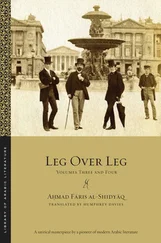413“the same said another way” ( wa-unufihā ): synonym of the preceding item, according to the Qāmūs .
414“two lines”: four hemistichs, each hemistich starting here on a new line.
415The word muʿqanafishan has not been found in any dictionary, but cf. ʿaqanfas , variant of ʿafanqas “ill-tempered, base” ( ʿasir al-akhlāq laʾīm ).
416“ bardhaʿah s… ikāf s… qitbah s… bāṣar s”: all types of saddle.
417“with a thread of paper” ( bi-khayṭin min al-kāghid ): perhaps referring to the domination of the bureaucracy by Turks.
418“leading… ‘leading’ him” ( yaqūdu… yaqūdūna lahu ): the author plays with two senses of the verb, qāda “to lead” and qāda li- “to pimp for.”
419“ bakalım kapalım (‘let’s see-bee’)”: the phrase is constructed by adding a non-existent word kapalım to the genuine word bakalım (“let’s see”) thus mimicking such genuine Turkish rhyming couplets as the preceding.
420“ Ghaṭāliq …”: most of the supposed Turkish of the following lines is in fact nonsense, though it does contain distinctive Turkish features, such as the ending — lik / lıq ; the first hemistich of the last line does make sense in Turkish (“They’re like donkeys too, by God!”), and the second hemistich of the same line can be read as near-meaningless Arabic (“Their troubles are their confusions”).
421“head… tail”: by “head” the author may mean the promontory of Raʾs al-Tīn (“the Head(land) of the Figs”) and by “tail” the land end of that promontory, where the popular quarter of Anfūshī, home to the city’s fish market, is situated.
422Qayʿar Qayʿār: an invented name that may be translated as something like “Plummy Pompous,” from the literal senses of qayʿar and qayʿār , both of which mean one who “speaks affectedly and from the back of his mouth” ( tashaddaqa wa-takallama bi-aqṣā famihi ). If we follow the clues offered by the similarly coded name Baʿīr Bayʿar (= al-Amīr Ḥaydar (1.5.2)), we may suppose that the first name of this individual may have been Ḥaydar, while the second may have been Bayṭār or another name of the same pattern. However, it is also possible that a European was intended (see next endnote).
423“the Himyaritic lands” ( al-bilād al-ḥimyariyyah ): i.e., southern Arabia, though the orthography also allows the reading al-bilād al-ḥamīriyyah , meaning “the lands of the donkeys,” and it is unclear whether the Fāriyāq is referring to an Arab or a “Frank”; some phrases and topoi in the passage that follows are reminiscent of those used when Franks are lampooned for their bad Arabic, as in the following chapter.
424“the science of ‘subjects’ and ‘objects’” ( ʿilm al-fāʿil wa-l-mafʿūl ): i.e., Arabic grammar.
425“chronograms” ( ʿilm al-jummal ): each letter of the Arabic alphabet has a conventionally assigned numerical value under a system known as hisāb al-jummal . The construction of chronograms capable of being read both as words and as dates became a common feature of congratulatory poetry starting in the ninth/fifteenth century. For examples, see Volume Four, section 4.20.13.
426 ʿĪsā : a proper name, cognate with “Jesus.”
427“within this p’tcher” ( fī hādhā l-kuzz ): kuzz appears to be a nonce-word derived from the common word kūz by shortening the vowel and doubling the second consonant, the charlatan teacher’s idea being that the word needs to contain a doubled consonant ( shadda , a word conveying the idea of “tightening”) to fit with something that is “confined”; the same logic might apply to zanbīl / zabbīl below, though both forms in this case are genuine.
428“ khams daqāʾiq … and not khamsah daqāʾiq ”: the humor lies in the author’s attribution of an irrelevant cause to a grammatical rule, the rule in this case being that a feminine noun (here the implied daqīqah , singular of daqāʾiq ) is preceded by the shorter, masculine, number form when counted.
429“because each is a ‘congregator of fineness’ ( jāmiʿ al-nuʿūmah )”: the language is that of rhetorical theory, which would claim that the words for “flour” and “minutes” share the same consonantal root ( d-q-q ) because flour consists of finely ground grain while minutes are fine divisions of hours, and the phrase might more accurately be rendered “because they share the common factor of fineness”; however, the wording is primarily a set-up for the play on words that follows a little later.
430“The first six have ‘parts’ at either end” ( al-sitt al-ʾūlā fī-hā farq ): i.e., “have distinct beginnings and endings”; however, sitt (“six”) also means in the Egyptian dialect “lady, mistress” (from sayyidah ), while farq (“dividing, partitioning”) also means a “parting” as a way of dressing the hair; thus, the words are a set-up to allow the joke that follows.
431“Nuʿūmah Mosque” ( jāmiʿ al-nuʿūmah ): while jāmiʿ is, as the shaykh will explain, an active participle, of the verb jamaʿa, yajmaʿu (“to gather together, collect, congregate”), it is also used in common parlance as a substantive meaning “mosque.”
432“ʿUdhrah… Virgin… must be stretched out” ( ʿUdhrah… ʿadhrāʾ… yajibu madduhā ): the learned monk wrote of a tribe famous for the celebration by its poets of passionate but unconsummated love; however, the ignorant Qayʿar Qayʿār, seeing ʿUdhrah , thinks that the monk intended ʿadhrāʾ (“virgin”), which should be pronounced with a long vowel at the end ( madd ), though in the colloquial it is pronounced with a short vowel. Thus, while stating a correct grammatical rule (the word for “virgin” should be written with —āʾ at the end), he demonstrates that “a little learning is a dangerous thing.”
433“ daʿawtu ʿalayh… ṣallaytu ʿalayh ”: the use of a preposition after a verb in Arabic, as in other languages, may modify the sense of the verb. Thus plain daʿawtu and ṣallaytu both mean “I prayed,” but daʿawtu ʿalayh means “I cursed him” whereas ṣallaytu ʿalayh means “I prayed for him.”
434“ tashīl… ishāl ”: verbs with the consonant-vowel patterns CVCCVCV (verbal noun form taC1C2īC3) and VCCVCV (verbal noun form iC1C2āC3) may have causative or declarative sense relative to the semantic area of the three-consonant root. Thus, from the root s-h-l , associated with “ease,” are created the verbs sahhala ( tashīl ) and ashala ( ishāl ). Each, however, has a different denotation. Thus, sahhala means “to make easy, facilitate,” while ashala means “to be struck with diarrhea.”
435Many of the words used in the letter are double entendres or malapropisms, as follows: “sodomitical”— ibnī “filial” may be read as ubnī (from ubnah (“passive sodomy”)); “penetrated it”— awlajtu should mean “I caused to enter” and is often used in connection with sexual intercourse, but here is used intransitively; “the shittiest part”— ukhrāh “its end” is both a deformation of ākhiratihi and also may be read akhraʾihi (from kharāʾ (“excrement”)); “excrements”— al-fuḍūl may mean either “(bodily) wastes” or “merits, favors”; “creator of pestilence”— al-fuṣūl may mean either “chapters” or “plagues”; “a ‘congregator’ of both the branches of knowledge and its roots”—the word jāmiʿ appears to be used here simply to maintain the running joke relating to “congregator/mosque,” which is resumed in the immediately following passage; “long of tongue”— ṭawīl al-lisān may intend “eloquent” but idiomatically means “impertinent”; “with ’ands too short to”— qaṣīr al-yadāni ʿan commits, for the sake of the rhyme, the gross grammatical error of al-yadāni for al-yadayni ; “of broad little brow”—reading wāsiʿ al-jubayn (counterintuitively in the diminutive) for the expected wāsiʿ al-jabīn (“broad of brow”); “wide waistcoated”—reading ʿarīḍ al-ṣudar (from ṣudrah “waistcoat”) for the expected ʿarīḍ al-ṣadr (“wide of breast, magnanimous”); “deeply in debt”—reading ʿamīq aldayn for the expected ʿamīq al-dīn (“deeply religious”); and “of ideas bereft”—reading mujawwaf al-fikar for mujawwif al-fikr (“pentrating of thought”), itself probably a spurious locution.
Читать дальше












